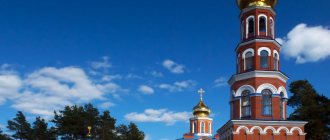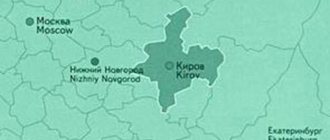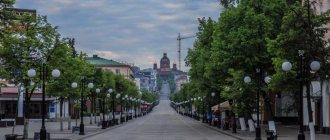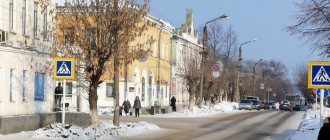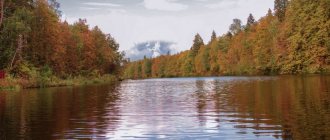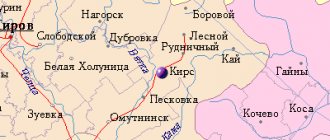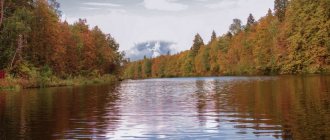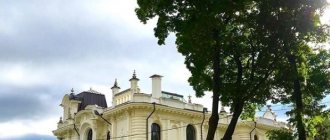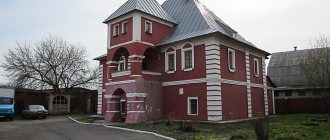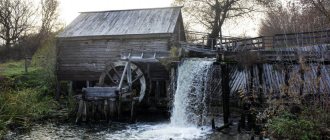Sights of Kirov – where to go and what to see
The history of Kirov, the sights of which are collected in this article, begins in 1374.
At that time, the settlement was called Vyatka, after the name of the river on the banks of which the first houses were built. In the middle of the 15th century the city began to be called Khlynov. At this time, the Novodevichy Transfiguration Monastery was created, and later the Trifonovsky Monastery; these sights of Kirov then played a major role in the development of the city and its history. Now, the city is a large industrial center. The sights and beautiful places of Kirov are visited not only by local residents, but also by tourists. If you decide to visit these places, we have selected the main attractions of Kirov, photos and descriptions, so it will be more convenient for you to navigate, plan your route and see all the beauty of the city not only in photographs. What to see in Kirov:
Assumption Trifonov Monastery
Assumption Trifonov Monastery is a male monastery in Kirov, founded in 1589 by Trifon of Vyatka.
At first there was a wooden temple on this site; in 1589 the Assumption Church was erected; six domes had different heights; according to historians, this was a unique structure of that time. A hundred years later, the structure became stone; everything was built from stone, even the fence that sheltered the monastery from prying eyes.
In the 20th century, most of the time the monastery was abandoned or used for the needs of the authorities. In 1991, the work of the monastery was resumed, and the entire ensemble was given the status of an architectural monument.
Address: Kirov, st. Gorbacheva, 4 Phone: +7 8332 64‑15-87 Opening hours: daily from 07:00 to 19:00
Variety of city monuments.
It should be noted that all cultural heritage sites are divided into several types: historical monuments (various buildings - Bekhterev's house or Green's house-museum); archaeological monuments (remains of the earthen rampart of the city of Khlynov); architectural monuments (the ensemble of the Trifonov Monastery, etc.) A special subtype of historical monuments includes steles, pedestals, obelisks, memorial areas and plaques that immortalized the heroic efforts and sacrifices of soldiers at the fronts and home front workers during the Great Patriotic War. All these objects may have the category of federal, regional or local historical and cultural significance.
Church of John the Baptist
A monument in Kirov that has great historical value is the Church of John the Baptist. It began to be built in 1714 on the outskirts of the city. The work was completed after 9 years, and at the end of the century the building was rebuilt, in particular the height of the main nave was increased.
During Soviet times, the church housed the Society for the Protection of Monuments, and the building was converted into a planetarium. The temple was returned to the Vyatka diocese in 1994. And at the moment it is the most beautiful landmark of the entire Vyatka region.
Address: Kirov, st. Svobody, 54d Phone: +7 833 265‑03-61 Open: daily, 7:00–19:00
Content
- 1 Project topic
- 2 Creative project name
- 3 Project idea
- 4 Project product
- 5 Authors and participants of the project
- 6 Project problem
- 7 Student Research
- 8 Variety of city monuments.
- 9 Our city bears the name of this man.
- 10 Monument to Vladimir Ilyich Lenin
- 11 Monument to artists, Vasnetsov brothers
- 12 Description of the participant’s activities
- 13 Criteria for evaluating work
theatre square
Theater Square is a popular place in Kirov. There are always a lot of walking students, families with children, and couples in love. The square is considered the real center of the entire cultural life of the city. This is where all the city holidays take place, and local residents nickname the square “theater room”. The building of the Regional Legislative Assembly is located on the square.
The Kirov Drama Theater gave the square its name.
Vyatskaya Vasnetsov is a museum visited by tourists coming to the city.
Address: intersection of Karl Liebknecht, Moskovskaya and Karl Marx streets
Tsiolkovsky Museum
In Russia there are only 4 museums associated with the name of Konstantin Eduardovich Tsiolkovsky and one of them is located in the city of Kirov.
The museum is located in the former mansion of the merchants Shuravins, and in 1873-1878 the family of the founder of astronautics lived here. The museum exhibits will clearly show how Tsiolkovsky lived; his personal belongings, editions of his lifetime works, documents and much more are stored here.
The museum is engaged not only in educational activities, but also in research activities, disseminating Tsiolkovsky’s ideas.
Our city bears the name of this man.
Sergei Mironovich Kirov
Monument to S.M. Kirov Sergey Mironovich Kirov
The name "Vyatka" is original. After the construction of city fortifications - the Kremlin - in 1457, the name “Khlynov” was assigned to the main city of the Vyatka land. But the name “Vyatka” did not disappear and all this time existed as the unofficial name of the city. In 1780, Empress Catherine II, by her decree, restored the historical name of the city and established Vyatka as the center of a vast province. December 5, 1934 By resolution of the All-Russian Central Executive Committee, Vyatka was renamed the city of Kirov. Moreover, in the Resolution Vyatka is called “the birthplace of Sergei Mironovich Kirov.” However, this is not true – S.M. Kostrikov (Kirov) was born on March 15, 1886 in the city of Urzhum, Vyatka province.
Sergei's parents came to the Vyatka province from Perm before his birth. From 1886 to 1901 Sergei Kostrikov lived in Urzhum. In the fall of 1901, fifteen-year-old Sergei left for Kazan and never returned to Urzhum. And in Vyatka S.M. Kostrikov (Kirov) never visited and never mentioned him in his speeches and works, i.e. his revolutionary and political activities are not connected with Vyatka. The renaming of Vyatka to Kirov had no basis in the history and culture of the city.
As a result of the renaming, the most original and striking phenomena of Vyatka culture (such as the Dymkovo toy or capo craft) lost their natural identification with the toponymy of the region and the regional center, and it itself almost lost its historical and cultural uniqueness, finding itself among many settlements , named after S.M. Kirov. In addition, S.M. himself Kirov participated in the Red Terror in Armenia and Azerbaijan, in the brutal dispossession of the working peasantry in the North-West of the RSFSR and in mass repressions against innocent residents of Leningrad. CM. Kirov participated in the repressions against outstanding scientists of the USSR Academy of Sciences. Until his last breath, Kirov remained a Stalinist, denying universal morality and hating democracy.
Vyatka Kunstkamera
The Vyatka Kunstkamera Museum is located in a 19th century house that belonged to the merchant Senilov.
There are five halls in the museum; the first exhibition was presented to visitors in 1992. These were collectible household items from the 19th and 20th centuries.
The Kunstkamera has a hall where natural wonders from different countries of the world are collected.
The museum hosts temporary exhibitions and displays private collections corresponding to the theme of the Kunstkamera.
Sculpture Family
Not long ago, a sculptural composition called Family was installed near the building of the Puppet Theater. The ensemble is made in the traditions of Dymkovo toys, it is a man with an accordion sitting on a bench, a woman with a child in her arms, a little boy standing next to him, a cat and a dog complete the composition. Next to them there is a place where you can take a photo or just sit on a bench.
The monument has become a symbol of family unity, and newlyweds come here to make a wish that will surely come true.
Address: Kirov, st. Drelevskogo, 22
Project idea
People pass by, rushing about business. It’s just that city residents don’t notice things that seem ordinary to them, but in fact are fraught with enormous cultural and historical value. Our city is associated with many great events and interesting people. We want to tell you about the buildings that preserve the memory of these events and people, that is, we want to tell you about the monuments of our city. These include sculptural monuments, busts, pedestals, memorial plaques and steles, of which we have a considerable number. The Department of Culture of the Kirov City Administration is concerned about the attitude of Kirov residents towards the cultural heritage of the city. In particular, skateboarders who “attacked the areas around the monuments, not honoring the memory of the heroes and destroying the integrity of the pedestals.”
We want to tell you more about the interesting monuments of our city. So that people remember the history and heroes of their city.
Alexander Garden
One of the oldest parks in the city, Alexander Garden, was founded in 1825, after Alexander the First visited Kirov.
A good location was chosen for green spaces between the Razderikhinsky ravine and Vyatka; the territory occupied the space between the Pyatnitsky Church and the Transfiguration Monastery.
By 1835, the garden was improved, with nice alleys, gazebos, and a stone bridge. The natural landscape fits well into the overall picture. Today, the Alexander Garden is the best example of park design dating back to the era of classicism.
Address: Kirov, Alexandrovsky Garden
Park named after Kirov
Kirov Park is located in the city center. The development of the territory began in the 70s of the last century; deciduous and coniferous trees, ponds, and lawns appeared. The appearance of amusement parks has made this place one of the leisure centers where families come to have a good time.
Now there are all conditions for recreation - equipped playgrounds, including children's, a beautiful fountain, anyone can rent a boat.
Any citizen or tourist here, on the Alley of Happiness, can order the insertion of tiles with their own name or inscription.
Address: Kirov, Oktyabrsky Ave., 147
Monument to Vladimir Ilyich Lenin
(1870–1924), (Real name - Ulyanov.) Revolutionary, political figure in Soviet Russia, leader of the Bolshevik revolution, one of the organizers and leaders of the October Revolution of 1917, chairman of the Council of People's Commissars (government) of the RSFSR and the USSR. Philosopher, Marxist, publicist, founder of Leninism, ideologist and creator of the Third (Communist) International, founder of the Soviet state. One of the most famous political figures of the 20th century. The scope of his main scientific works is philosophy and economics, head of the Soviet government (1917–1924).
Wish tree
In the park, not far from the Drama Theater. Kirov has a unique composition, the Tree of Wishes. Laying the foundation for the tree lasted a week. Letters with the wishes of the townspeople were placed in a box under the tree, that is, thanks to this, it grows, of course, only symbolically.
The opening of the art object was a celebration. At the ceremony, those present shouted “I allow” in unison, which became a sign that the tree would grow and fulfill everyone’s wishes to the joy of everyone. An ear is carved on a tree; everyone can come here and whisper their deepest desire. It is interesting that the concrete tree looks like a real one, it is so skillfully made by craftsmen.
Top attractions (727)
Kazan City Hall is located in the central part of the city, on Freedom Square. Nearby is the building of the Concert Hall. S. Saidashev and the Opera and Ballet Theater named after. M. Jalil. The town hall building was built in 1854.
Two 46-meter-high steles in the shape of a half-opened book were installed on the shore of Izhevsky Pond in 1972. A group of sculptors and architects led by A.N. Burganov and R. worked on the creation of the monument.
The light green building in the Art Nouveau style on the historical street of Syzran was built in 1908 for the member of the Syzran district Zemsky Assembly, Pyotr Vasilyevich Revyakin. P.V. Revyakin was also the founder of the first pawnshop in the city and one of the three directors of the Relyevsky Mills Partnership.
The symbol of the city of Engels is the salt bull. And although the monument was erected relatively recently (June 12, 2003), the history of the symbol goes far into the past. Salt was once worth its weight in gold. It was usually mined from salt lakes.
The building of the Saratov State Conservatory was built in 1902 by St. Petersburg architect A.Yu. Yang for a music school. In 1912, under the leadership of architect S.A. The Kallistratova building was reconstructed and added elements of South German Gothic.
In the central district of Naberezhnye Chelny there is an Art Gallery, founded in 1980 as a branch of the State Museum of Fine Arts of Tatarstan. As a state repository of art treasures, the gallery carries out cultural, educational and scientific research activities.
On the day of national unity and the ninetieth anniversary of the statehood of Udmurtia - November 4, 2010, an unusual monument was inaugurated on the central square of Izhevsk. The author of the idea is Nikolai Khaliullin and the sculptor P.
The most touching monument in Togliatti, which has become an urban legend, is located on the Southern Highway in the Avtozavodsky district. On a granite pedestal stands a one and a half meter bronze sculpture of a German shepherd, whose boundless devotion still touches the hearts of millions of motorists.
The Kul Sharif Mosque is the main mosque of Tatarstan and Kazan. The construction of the mosque was completed in 2005 and dedicated to the thousandth anniversary of Kazan. The mosque is located in the western part of the Kazan Kremlin.
One of the main regional monuments dedicated to labor and military exploits in the Great Patriotic War in the city of Penza is the Victory Monument. The memorial, installed on May 9, 1975 in a new microdistrict, which later became the central district of the city, has a height of 5.6 meters and is now part of the architectural composition of Victory Square.
On the approach to the Yelabuga settlement in 2007, a monument was erected to the founder of the city - the Bulgarian emir Ibrahim I ben Muhammad. The authors of the bronze monument, weighing fifteen tons, were: Kazan sculptor Makhmud Gasimov, artist Firinat Khalikov and architect Marat Maskudov.
In November 1967, a monument was unveiled in the capital of Bashkiria, Ufa, which for almost half a century remains the largest equestrian statue in all of Russia. The grandiose sculpture, weighing forty tons and almost ten meters high, was installed at the highest point of the city, on a steep cliff rising above the Belaya River.
100 km from Penza there is a most picturesque place - the Tarkhany Museum-Reserve, where the brilliant Russian poet Mikhail Yuryevich Lermontov grew up. A unique historical and cultural monument was opened in the village of Lermontovo (formerly the village.
On April 12, 1961, near the city of Engels, Saratov region, residents of the village of Smelovka heard an explosion in the sky and saw two parachutes descending to the ground. The villagers then had no idea that they were witnessing a historical event on a global scale.
The monument to Musa Jalil, the Tatar poet and patriot, is located at the main entrance to the Kazan Kremlin, not far from the Spasskaya Tower. The sculpture was installed in 1966. The authors of the monument were sculptor V.E.
On June 23, 2011, in the center of the capital of the Republic of Mari El, a sculptural composition of a folklore character, Yoshka the Cat, was installed. The bronze sculpture weighing 150 kg, cast in Kazan, is the result of the work of two Yoshkar-Ola sculptors Anatoly Shirnin and Sergei Yandubaev and Muscovite Alexei Shilov.
Opera and Ballet Theater named after. Musa Jalil is located on Freedom Square in the center of Kazan. Construction of the theater building began in 1936. The author of the project was Moscow architect N.P. Skvortsov. In 1948, the building's facades and interiors were redone under the direction of Kazan architect I.
The State Nature Reserve of Bashkiria with an area of 22,531 hectares, located in the Burzyansky district, was created in 1958. The name Shulgan-Tash is translated from Bashkir as “a river that has fallen into stone.”
A beautiful mansion with an openwork fence and griffins at the front entrance adorns the historical part of the city of Kirov. The building in a mixed Gothic style with oriental exotic motifs belonged to the owner of the Vyatka-Kama Shipping Company, philanthropist and eminent merchant Tikhon Filippovich Bulychev.
The Tatar State Puppet Theater "Ekiyat" was created in 1934. It is considered one of the oldest children's theaters in the country. Over the entire history of the theater, about three hundred performances were staged. Now the theater's repertoire includes more than forty performances: productions of fairy tales from peoples of the world, historical performances and productions with modern themes.
Idols of the past. PHOTO
On April 18, Monument Day is celebrated around the world. The most iconic monuments of Kirov - lost and surviving to this day - are in our archival photo selection.
On April 18, the entire cultural community of our planet celebrates the International Day of Historical Monuments. On the eve of this event, a journalist from the portal Svoykirovsky.rf visited the State Archives of the Kirov Region in order to find photographs of the last century and remember what the monuments of our city used to look like.
The most recognizable monuments, as well as those that have not survived to this day, come from the Soviet era and exclusive footage from the opening of some of them - in our photo report.
My favorite name
For many years now, disputes over the renaming of our city have not subsided. One way or another, today Kirov bears the name of the legendary Soviet politician, “a boy from Urzhum.” Of course, for many years the local party elite tried in every possible way to perpetuate the memory of the big party boss, whose pseudonym gave Vyatka a new name.
Of course, in this regard, the most famous and fundamental is the monument to Kirov on Oktyabrsky Prospekt near the Central Department Store. Its grand opening took place on November 6, 1966.
Less pompous both in size and in sculptural composition is the monument to Sergei Mironovich on Lepse Square. Note that the photograph of this monument is dated 1965.
However, until this time, this place was occupied, so to speak, by an even more modest Kirov. However, this monument, as the photos show, was also not the very first version of the monument to Sergei Kirov. In the 30s, the completely ascetic Kirov, made of plaster, looked at the entrance of the plant, then named after KUTSHO.
Let us note that previously the above sculpture was located in the Alexander Garden near the Chess House, after the liquidation of which it was moved to the square.
Let us add that monuments to Kirov eventually appeared in his small homeland - in Urzhum, and busts of “Mironych” can still be seen in the building of the Drama Theater and in the foyer of the Kirov-1 railway station.
Leaders on Vyatka
In Soviet times, the main sculptural trend throughout the country was the widespread installation of monuments to Lenin. Our city in this regard, of course, was no exception.
When mentioning the monument to Lenin, the image of the leader of the world proletariat on Theater Square immediately appears before the eyes of every Kirov resident. Let us note that the legendary creation, created by architects Koshkin and Shpak, appeared in Kirov in 1970 in honor of the 100th anniversary of the famous Russian revolutionary.
Let us note that the opening ceremonies 50 years ago were not much different from today's celebrations - the same first rows of high-ranking officials, pathetic speeches, cutting the red ribbon and the traditional removal of the white cloth from the newly made sculpture.
Another monument to “grandfather” Lenin was located near the Bishop’s house on Moskovskaya Street. In the 60s, pioneers took an oath here under the stern gaze of Vladimir Ilyich.
A more elegant monument to Lenin was once located on the XX Party Congress Square. I must admit, it looked very harmonious in the green park, made in the capital’s style.
But in 1983, the former Lenin was replaced by a “bump-shaped” granite bust, which remains in the park to this day.
Of course, in pre-Khrushchev times, there were many monuments in Kirov dedicated to another legendary leader of the Soviet era - Comrade Stalin. The most famous in this regard was the monument on the Green Embankment.
Let us remember that before Stalin, there was a Trinity Cathedral in this place, which was demolished in the 30s. local authorities. After the 20th Congress of the CPSU, the monument to Stalin suffered the same fate. Today, this place houses the Eternal Flame.
Monument to a terrorist
In the early Soviet period, when the pantheon of heroes of the October Revolution and the Civil War had not yet formed in the country, in the Vyatka province the famous Vyatka terrorist-revolutionary Stepan Khalturin was elevated to the rank of revered freedom fighters. It was he who tried to kill the Tsar and carried out an unsuccessful explosion in the Winter Palace.
The location for the monument was chosen on the Lower Trade Square, between the Trinity and Spassky churches. In 1923, the grand opening of the monument took place, which grew into real mass celebrations.
And here is a monument to Emperor Alexander III, whose father the same Stepan Khalturin tried to kill. A bust of the emperor was installed near the Alexander Nevsky Temple. After the temple was blown up, the monument was also dismantled.
As fate would have it, the pedestal of the bust was used by the architects for the monument to Khalturin, which can be seen at the stage of construction work. Fate has such a strange sense of humor.
Herzen
Perhaps this was one of those monuments of the Soviet period, the installation of which was the least politicized project. The bust of Herzen in Kirov appeared, first of all, in gratitude for the creation of the main public library in the region.
Although Herzen had a certain loyalty from the local authorities due to his seditious opposition works, as well as for serving political exile in our region.
One way or another, in 1948 the monument was inaugurated near Herzenka.
There is also a photo of what the bust looked like during construction. Let us add that the monument has remained unchanged to this day, except that the decorative fence that framed the corner of the library has disappeared. Today, new monuments and art objects continue to appear in Kirov, although in our days monumental construction has become somewhat smaller.
Which monuments do you like better – Soviet or modern?
The Svoykirovsky.rf portal expresses gratitude to the management of the State Archives of the Kirov Region and the institution’s specialist, Alexey Leontyev, for their assistance in creating the material.
PHOTO taken from GAKO funds
Architectural monuments and museums of Kirov
We will not sin against the truth if we say that Kirov is one of the most beautiful cities in Russia. Many businessmen and tourists come here every year. The former come here for business purposes, the latter to see the sights of Kirov. And this year there is one more reason to visit the ancient city - the first ever Fairytale Games started, which attracted hundreds of tourists from all over our vast country. And, of course, many of them rented apartments for daily rent in Kirov, due to the fact that hotels simply could not cope with such an influx of tourists. But that’s not about that now.
Now we want to tell you about the architectural monuments and museums of the city . Let's start with the monuments, most of which are located in its central part, which is located on the high bank of the Vyatka River. These monuments are silent witnesses to the affairs of bygone days and an excellent illustration of the rich history of the Khlynovskaya fortress (the original name of the city of Khlynov - read more about this in this article).
The first architectural monument we will visit is located on the slope of the Zasorsk ravine, south of the fortress. More precisely, it is a whole complex of monuments. Its name is the Holy Dormition Trifonov Monastery (Gorbachev St., 4). The monastery is active, revived in 1991. Its main attraction is the magnificent five-domed Assumption Cathedral , built in 1864-1889. The interior of the cathedral is distinguished by a five-tiered iconostasis with ancient icons, which was restored in the 20th century and covered with wonderful Palekh painting. Also prominent in the ensemble of the monastery are: the gate St. Nicholas Church, opened in 1690-1695, the Annunciation and the Three Saints churches, and cells. Pilgrims can easily rent rooms for daily rent in Kirov in the vicinity of the monastery, which, you see, is nice.
In general, everything is fine with the monasteries in a city with a clearly communist name; this is apparently a kind of mockery of fate. Another famous religious building of the city is the ensemble of the Spaso-Preobrazhensky Novodevichy Convent , founded in 1624, with the incredibly elegant and festive Spaso-Preobrazhenskaya Church . True, his address is somewhat mysterious: Dinamovsky Proezd, no. 6. But I think you won’t get lost in any case. Architectural monuments of the 17th century are located here. The monastery was restored in 2001 and is currently active.
The Church of St. John the Baptist (54-d Svoboda St.) from the 18th century is very unique For many townspeople, it is not even associated with the church. There was a planetarium here until the 60s. And only in 1994 the building was transferred to the jurisdiction of the diocese. Then his long recovery began, almost piece by piece.
The stone Trinity Church (Proezzhaya St., 27) was built in 1770-1775 by Khlynovsky architects Vasily Shvetsov and Pyotr Rupasov. This magnificent example of a tiered temple has survived to this day practically without reconstruction, especially significant ones. Which is very rare. The building has recently become located within the city, so keep in mind that in this area you can still rent a picturesque house for daily rent and enjoy provincial peace and tranquility.
After visiting religious buildings, you can go to see the monuments of civil architecture. Such as: the building of the former official hut (Drelevskogo St., 4 b), the buildings of provincial government offices (Dinamovsky Proezd, 2, 4), made in the style of classicism. Among the civil architectural monuments, the complex of park buildings located in the Alexander Garden (read more about this in the Green Kirov route) especially stands out. However, it would take a long time to list what you will see on site; we advise you to simply walk through the center of Kirov and see everything for yourself. Unfortunately, in all these eclectic mansions with intricate carvings, stone giants from the Classical era, apartments are not available for daily rent in Kirov, but you can find more comfortable housing, even if not in a historical building.
As for museums, they are often associated with the names of artists, writers, and architects who were in one way or another connected with the city of Kirov. The Vyatka Folk Art Crafts Museum is especially popular among tourists . This is understandable. After all, Vyatka is the birthplace of the famous Dymkovo toy. The museum is located in the above-mentioned architectural monument - Prikaznaya Izba (Drelevsky St., 4b). However, the museum exhibits are very diverse: lace, clay products, embroidery and weaving samples.
Another interesting museum is the Art Museum named after V.M. and A.M. Vasnetsov (Karl Marx St., 70). It opened in 1910. This is one of the oldest art museums in our country. It is located in a beautiful building of the 19th century. The exhibition included quite interesting collections of Western European and Russian paintings, as well as ancient icons.
There are also literary museums in Kirov. One of them is the House-Museum of A.S. Green (Volodarsky St., 44). The only one in Russia, by the way. It was built in the place where the writer spent his childhood and youth.
Another literary museum is closely connected with the name of the famous Russian satirist M.E. Saltykov-Shchedrin ( House-Museum of M.E. Saltykov-Shchedrin - Lenin St., 93), who was exiled into political exile in Vyatka and lived here for seven years. The writer rented rooms for daily rent from I.H. Rush, a foreman at the Medyansk paper mill. And in 1968, a museum was opened in this house on a voluntary basis.
Museum of K.E. Tsiolkovsky , aviation and astronautics in Kirov (Engelsa St., 16) is one of four museums associated with the name of this great scientist in Russia. It opened its doors to visitors in 1988. It is located in a historical building that once belonged to the merchants Shuravin. Doesn’t really fit in with space, does it? The fact is that the Tsiolkovsky family once lived here. Yeah, apparently they rented apartments for daily rent in Kirov, no less.
Well, for dessert we advise you to go to the Vyatka Kunstkamera (Moskovskaya St., 12-a). In five halls of which there are... no, not preserved corpses of babies. Here there are exhibits in one way or another related to urban life of the 19th century: collections of watches, porcelain, earthenware, furniture and various artistic products. As you can see, the city can surprise. And it’s nice to be surprised. After all, Kirov is one of the oldest cities in Russia!
With this, we say goodbye to you and wish you a pleasant journey and a sea of bright impressions. October 27, 2016 Tags: Routes , Interesting places , Museums , Temples
Architecture. Urban planning
Skopin E. L., Krivosheina N. V. Monuments of architecture, urban planning and monumental art of the Kirov region. Issue 4. Verkhnekamsky and Darovsky districts. Materials for the Code of Historical and Cultural Monuments of the Kirov Region. – Kirov, 2010. A4 format, 356 pp., 567 b/w illustrations, 20 pp. color/illustration.
The fourth issue of this serial publication presents material showing historical and architectural landmarks located in the territories of the Verkhnekamsk and Darovsky districts. Familiarity with cultural heritage sites of various types, purposes and dates of construction continued. For the first time, the architecture of the villages of Lesnoy and Sozimsky, whose formation in the late 1960s, is presented. 1930s associated with the activities of Vyatlag. Articles on individual religious monuments are supplemented with material on monumental painting shown in color illustrations. There is also space reserved here for new sections, in which additions to previously published materials are offered to the attention of readers. The publication of materials is carried out as part of the preparation of the Code of architectural monuments and monumental art of the Kirov region. For architects, engineers, historians, art critics, museum employees, tour guides and anyone interested in the history and art of the Vyatka region.
About the series of books “Monuments of architecture, urban planning and monumental art of the Kirov region”
The literature, prepared in the form of detailed directory catalogues, is devoted to the architectural sights of individual districts of the Kirov region. The contents of the books consist of separate publications about preserved and lost temples and mosques, residential, public and commercial buildings, objects of industrial architecture, and small forms. Each article includes historical information about architectural monuments and historical buildings, a description of their appearance and characteristics of their artistic merits. Each book is richly illustrated with black-and-white and color archival and contemporary photographs, measured and archival drawings, graphic reconstructions, and scientific reference apparatus. The books are intended for both specialists: architects, builders, historians, art critics, museum employees, tour guides, and a wide range of antiquity lovers: local historians, teachers, schoolchildren and anyone interested in the history of the Vyatka region.
All of these books were reviewed at the State Institute of Art Studies, in the department of the Code of Monuments of Artistic Culture. Each of the books participated in the “Best Printed Edition on Architecture and Architects” competitions of the International Festival “Zodchestvo” in different years and has received diplomas from this festival (book No. 3 has a bronze diploma).
The book can be purchased from the author (E-mail, tel. 8-912-828-4493). Price 350=00. When paying by bank transfer, the cost will increase by 6%. When sent by mail, the cost will increase due to actual postage costs.
Five monuments of the Vyatka Baroque in the Kirov region that can be seen over the weekend
The weather is not kind this summer, but staying at home is a bad idea, we decided and went to see the Vyatka architecture of the 17th - 18th centuries. Or rather, the temples and cathedrals that have been preserved in the vicinity of Kirov. Let’s say right away that you can look at them for hours, and you can trace from them how the architectural style has changed on Vyatka land.
By the way, the first brick buildings in Khlynov appeared only at the end of the 17th century. Due to the high cost of brick, this material was used mainly for the construction of religious buildings, and temples were founded on voluntary donations from local residents and patrons of the arts. At that time, the Moscow Baroque architectural style was gaining popularity in Central Russia, the distinctive feature of which was the upward movement of buildings, their multi-tiered and patterned facades. It replaced another popular style - patterning, which was characterized by intricate shapes, complexity of composition and abundance of decor.
Spaso-Preobrazhenskaya Church (Kirov, Dinamovsky proezd, 6)
Our trip begins with this temple. The Transfiguration Church is one of the surviving creations of the famous artel of local craftsman Ivan Nikonov, whose craftsmen had a hand in creating many stone buildings in Khlynov in the early 18th century. The church was built in 1696. At that time, buildings were decorated with intricate brick carvings with folk art and scope in the spirit of Russian pattern design. With the originality already inherent in Vyatka masters. As you can see, window casings add elegance to the façade.
To get closer to the Church of the Transfiguration, you need to show patience and perseverance. The fact is that the temple is surrounded by a fence, behind which you can go “only with the blessing of your mother.” We, of course, managed to get through the fence - it was open due to construction work, but when they saw us, they sent us for a blessing.
Temple of the Trinity Church (Kirovo-Chepetsky district, Kstinino village, Sovetskaya str., 61)
Half an hour's drive from Kirov in the Kirovo-Chepetsky district is the village of Kstinino. Driving through it, it is impossible to miss the bell tower of the Trinity Church in the classicism style of the 19th century. It attracts the eye with its scale. However, behind it lies another architectural monument - a temple built at the turn of the 17th - 18th centuries.
Before us is a façade decorated with brick carvings and platbands, and each one is different in some way. Unfortunately, it is clear to the naked eye that this majestic temple needs restoration.
Cathedral of St. Nicholas the Wonderworker (Nolinsk, Lenin St., 33a)
The journey from Kstinino to Nolinsk takes almost two hours, but what we saw was worth the long journey. Firstly, on the way to the city you can stop in the village of Kyrchany, where there is a bell tower of the Life-Giving Trinity, built in the second half of the 18th century, also in the Vyatka Baroque style. And secondly, in Nolinsk there is the Cathedral of St. Nicholas the Wonderworker of the first quarter of the 18th century. It was formerly surrounded by a large wall, the remains of which can still be found near the temple.
The platbands on the windows catch your eye. The curls on them rise upward, turning into a new row of curls. Between the first and second rows there is space left for other patterns, and the window kokoshniks have an additional decoration - there are rosettes inside them. Moreover, such a riot of imagination does not burden the decor of the cathedral, but creates a special appearance.
In Nolinsk we stopped briefly to rest and have a snack at the “Culinary” on the street. Communes, 7, there are very tasty and cheap baked goods. By the way, a spoiler: the next “Own Route” will be dedicated specifically to Nolinsk. We will tell you in detail what is remarkable about this city and what you can see here.
Church of the Sign and Mother of God (Kirovo-Chepetsky district, Pasegovo village, Podgornaya st., 14)
From Nolinsk we headed to the village of Pasegovo to see the Church of the Mother of God of the Sign, built in the first half of the 18th century. The distance between settlements is more than 220 kilometers and more than two hours’ drive.
This church is one of the pearls of Vyatka architecture. It was built in the first half of the 18th century. Now it is being restored, and the restored facades frankly delight the eye with their pomp.
We were again lucky to have good people and were able to communicate with restorers. They say that when recreating the patterns, they had to comprehend the intricacies of brick carving, and some of the patterns were recreated from flask stone - it is much more convenient to work with.
Before heading to the next settlement, we filled up the tank at the Dvizheniye gas station near the village of Strizhi. There we also picked up aromatic coffee and pastries for the road. By the way, now all Dvizhenie gas stations in the Kirov region sell a lot of useful products for outdoor recreation, which is very convenient.
Catherine's Cathedral (Slobodskoy, Volodarsky St., 54)
Another interesting monument of the Vyatka Baroque is the Catherine Cathedral in Slobodskoye. The building was built at the turn of the 17th – 18th centuries, and in it, as in the Church of the Transfiguration, one can see the architectural style of the artel of Ivan Nikonov. If you have time, you can devote a separate day to it, at the same time exploring other sights of Slobodskoye.
In 1914, the cathedral was rebuilt according to the design of the architect Ivan Charushin, two chapels were added - from the south and north. The decorations of the ancient part of the church have been preserved.
This is such an unusual trip this time. We returned late in the evening, tired but happy. We wish the same for you, because traveling to your native land is cool.
Where to refuel on the way to the cultural monuments of the Vyatka Baroque, see on the map:
Monument to the artists, Vasnetsov brothers
Artists Victor and Apollinary Vasnetsov were born in the Vyatka province in the family of the priest Mikhail Vasilyevich Vasnetsov. Viktor Mikhailovich did not come to religious painting right away. He was an Itinerant artist, wrote monumental epic canvases on the themes of Russian history (“John the Terrible”), folk epics and fairy tales “Ivan the Tsarevich”, “The Flying Carpet”, “After the Massacre”, “Alyonushka”, “Bogatyrs” . Apollinariy Mikhailovich is a painter, graphic artist and archaeologist. He painted poetic views of ancient Moscow, epic landscapes of the Moscow region, the Urals, etc. In addition, Apollinary Mikhailovich also worked as a theater artist: he painted scenery for the play Sadko.
Herzen Alexander Ivanovich (1812 (Moscow) - 1870 (Paris))
Main pseudonym Iskander, Russian prose writer, publicist. Born on March 25 (April 6), 1812 in Moscow in the family of a noble Moscow gentleman I.A. Yakovlev and a German woman, Louise Haag. Oral memories of living witnesses of the war with Napoleon, the freedom-loving poems of Pushkin and Ryleev, the works of Voltaire and Schiller - these are the main milestones in the development of the soul of young Herzen. The uprising of December 14, 1825 turned out to be the most significant event in this series. In 1833 Herzen graduated from the university with a silver medal. Herzen died in Paris on January 9 (21), 1870.
Oktyabrsky Prospekt - T-34 tank
There are different versions of where this tank came from. In fact, the T-34 tank was sent to Kirov in 1967 at the written request of the regional leadership from the Ural Military District. The tank arrived without an engine by rail. It was loaded onto a heavy-duty vehicle platform, pulled out by tractor to Oktyabrsky Prospekt, and then, at night, lifted and installed by two cranes.
Victory Park - BTR-70
The car was written off and, at the request of the regional leadership, it was handed over to Kirov and installed as a monument. The armored personnel carrier came to us from Yoshkar-Ola around 1999.
Monument to Alexander Green on Green embankment
Monument to revolutionaries.
Restoration work was carried out for about two years. The monument was literally raised from the ashes.
Monument to an ancient seal
The seal is the basis of the coat of arms of the Vyatka province. An unusual monument has appeared in the center of business activity in Kirov. Concrete seal weighing 3 tons. The monument was created at the expense of small entrepreneurs. Symbolizes the connection of times between merchant traditions and modern entrepreneurship.
Monument to the victims of political repression.
The basis for the monument was a piece of red granite that had been kept in the workshop of Vyatka sculptor Vladimir Bondarev for 25 years. The granite slab once served as a pedestal for the monument to Alexander III. The stone statue of the sovereign was located opposite the Alexander Nevsky Cathedral, built by the famous architect Witberg. In the thirties of the last century, the cathedral was blown up, the monument was destroyed, the only thing left of the unique architectural complex was that same piece of red granite. Meanwhile, in Vyatlag alone, tens of thousands of innocents died every year - more than in Buchenwald. There were no gas chambers on Vyatka. They died of hunger and diarrhea. People were buried by throwing them into a pit, and, in the best case, a cross was placed over this place. Until now, the relatives of the victims do not know where their loved ones are buried. Now a symbolic place has appeared in Kirov where one can come to venerate the memory of the innocently killed.
Monument to the stork
In the center of the city, the Stork made its nest - a symbol of family happiness.
Koneva Street is located in the South-Western district of the city of Kirov. It is named after our fellow countryman - the famous commander Ivan Stepanovich Konev, who was born in the village of Lodeyno, Vologda region (now Podosinovsky district, Kirov region). The leadership talent of I.S. Konev was especially evident during the Great Patriotic War. The troops under his command heroically fought against the fascist invaders, stormed Berlin, and liberated Prague. After the war, Konev was Commander-in-Chief of the Ground Forces, First Deputy Minister of Defense of the USSR and Commander-in-Chief of the combined Armed Forces of the Warsaw Pact countries. A monument to our talented fellow countryman was erected on Konev Square; the streets of cities and towns of the Kirov region, the library of the village were named after him. Lodeyno and state farm of Podosinovsky district.
The largest monument in the region, a 7.5-meter sculpture of Marshal Konev, has an unusual fate. The monument was created by Pole Antoni Haydecki. It was erected in Krakow in 1985, in honor of the 40th anniversary of the liberation of the city from the Nazis. But soon some extremist-minded Poles began to commit acts of vandalism against the immortalized commander. And in 1990 they completely dismantled it. In 1994, the disfigured monument was transported to Kirov. Now the sculpture is installed on Konev Square. According to unverified data, the giant, disproportionate hand of the marshal was made and attached by a certain Kirov master. Currently, this monument is the main attraction of the South-Western district of the city.
Victor Savinykh.
The monument to the legendary fellow countryman stands on the territory of the Tsiolkovsky Museum of Aviation and Cosmonautics. This is a bronze bust on a granite or marble pedestal. Viktor Savinykh has three flights into space. In total, he spent more than 250 days in orbit. Viktor Petrovich - twice Hero of the Soviet Union, honorary citizen of the Kirov region and the city of Kirov.
Eternal flame
This installation with the Eternal Flame is part of the memorial complex installed on the city's Green Embankment in memory of the Kirov soldiers who died on the fronts of the Great Patriotic War. The procession dedicated to Memorial Day, with the participation of government and public representatives, has become traditional in our region.
